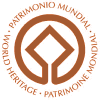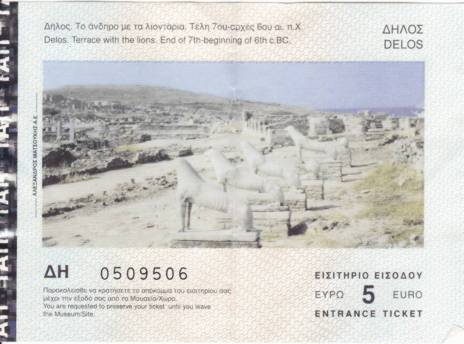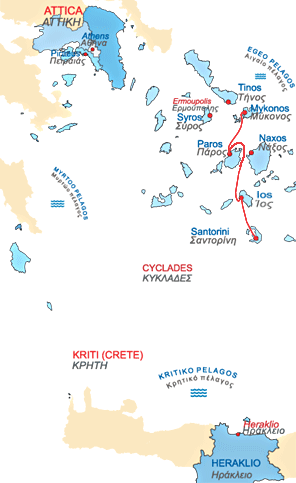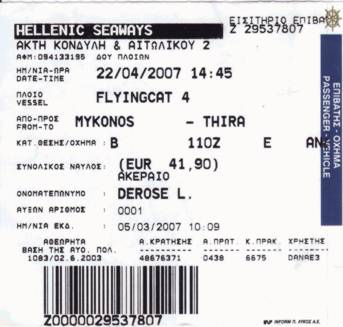Κυριακή, κβʹ Απριλίου ͵βζʹ
| 20 | κʹ | |||
| 21 | καʹ | |||
| 22 | ● | κβʹ | ||
| 23 | κγʹ | |||
| 24 | κδʹ | |||
| 25 | κεʹ | |||
| 26 | κϝʹ | |||
| 27 | κζʹ | |||
| 28 | κηʹ | |||
| 29 | κθʹ | |||
| 30 | λʹ | |||
| 1 | αʹ | |||
| 2 | βʹ | |||
| 3 | γʹ | |||
| 4 | δʹ | |||
| 5 | εʹ | |||
| 6 | ϝʹ | |||
| Sunday Morning in Mykonos |
We woke up early and checked out of the Philippi, leaving our luggage in the common room and walking down to the waterfront for breakfast. This solidified my love of Mykonos: Breakfast was delicious (crêpe with honey and nuts [me] and crêpe with ham, cheese, and mushrooms [Billy]), in a seaside café filled with locals. And Myknonos had exactly the feel that one desires from a whitewashed town on a busy Greek island: old women on morning errands; fresh fish at the port; incense billowing out of Orthodox churches no bigger than our living room.
Church near our Hotel |
| Delos |
| World Heritage Site | ||||||||||||||||||||||||||||||||||||||||||||||||||||||
|
||||||||||||||||||||||||||||||||||||||||||||||||||||||
But we weren't really here to see Mykonos: We were here to see
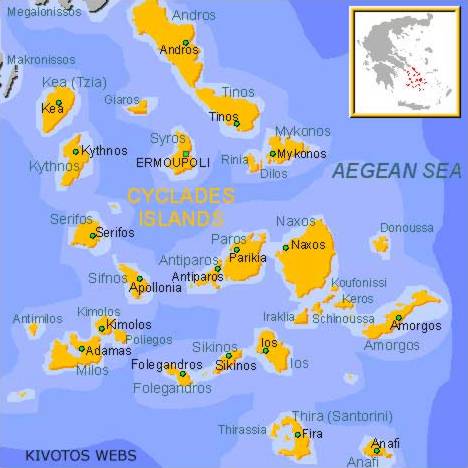 |
Cyclades |
- Geography: The Greek islands can be thought of as half the nation of Greece – if not in land area, at least in footprint, and definitely in importance. Most (but not all) of them are thought of in general terms as the Aegean Islands, but there are several major clusters: the
EN Sporades EL Σποράδες , theEN Ionian Islands EL Ιόνια νησιά , theEN Dodecanese EL Δωδεκάνησα , and, most important to us, theEN Cyclades EL Κυκλάδες . The Cyclades are so named because they encircle what would appear to the untrained eye as a fallow and useless spit of land known as Delos. But Delos is not smack in the middle; rather, it is simply important enough that it is the central focus of anything remotely close to it; geographically, it lays just off the cost of Mykonos (hence our journey). The Greeks get poetic in their description of Delos's geographic relation to the rest of the Cyclades: Our guide to Delos stated unselfconsciously that the other islands form a "dance circle" around it, and noted that Callimachus referred to it in the third century as the "hearth of the islands." - History and Mythology: Delos is arid, unsuited for agriculture, bereft of resources, and uninhabitable without outside provisions. But an offer was made to spare it from oblivion: Leto, looking for a location where Apollo could be born, presented the following option to the island:
Delos, if you would be willing to be the abode of my son Phoebus Apollo and make him a rich temple –; for no other will touch you, as you will find: and I think you will never be rich in oxen and sheep, nor bear vintage nor yet produce plants abundantly. But if you have the temple of far-shooting Apollo, all men will bring you hecatombs and gather here, and incessant savour of rich sacrifice will always arise, and you will feed those who dwell in you from the hand of strangers; for truly your own soil is not rich. – Homeric Hymn to Delian Apollo |
Delos took the deal (albeit with conditions; you can look it up yourself if you want to understand all of the contract negotiations between Leto and the island).
And Delos thrived, and a bustling community arose, and it came to look like this:
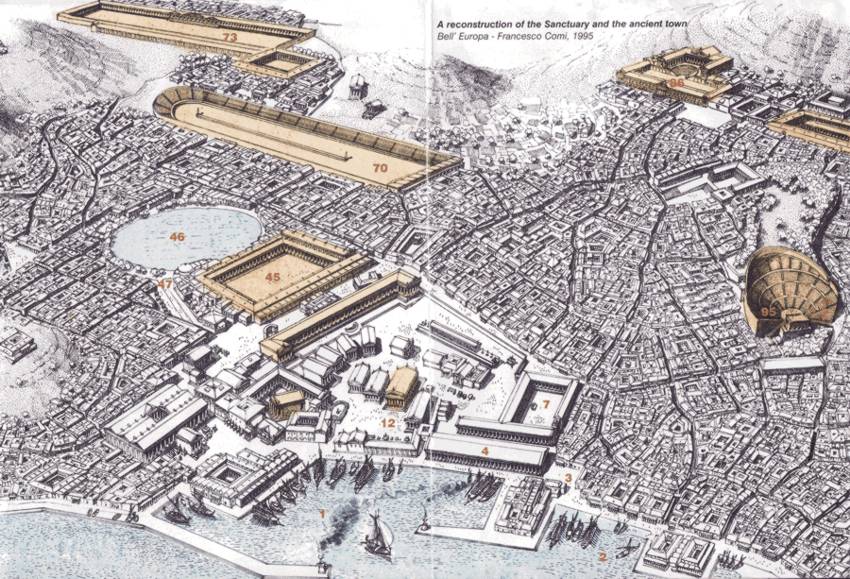 |
| Delos (In Its Prime) |
And though Delos is again uninhabited (by order of the Greek government), the "incessant savour of rich sacrifice" continues to rise, and the island continues to be fed "from the hand of strangers."
And we strangers were there to feed it. So after breakfast we crossed to Mykonos's Old Jetty (the lesser downtown port) for the trip to Delos. We had been told by one agency that the earliest trip was 10:00, but confirmed at the dock that we could sail at 9:00 (actually 9:20, but only because they were waiting for a large Italian youth group). Other tourists in the line said the man who advised me about tickets was unfriendly, but I found him quite helpful, perhaps because I started the conversation with,
I suspect that my habit of getting repeated confirmations for each detail is annoying (not least to my traveling companions), but unfortunately for us all, the behavior is reinforced constantly as in these examples.
|
|
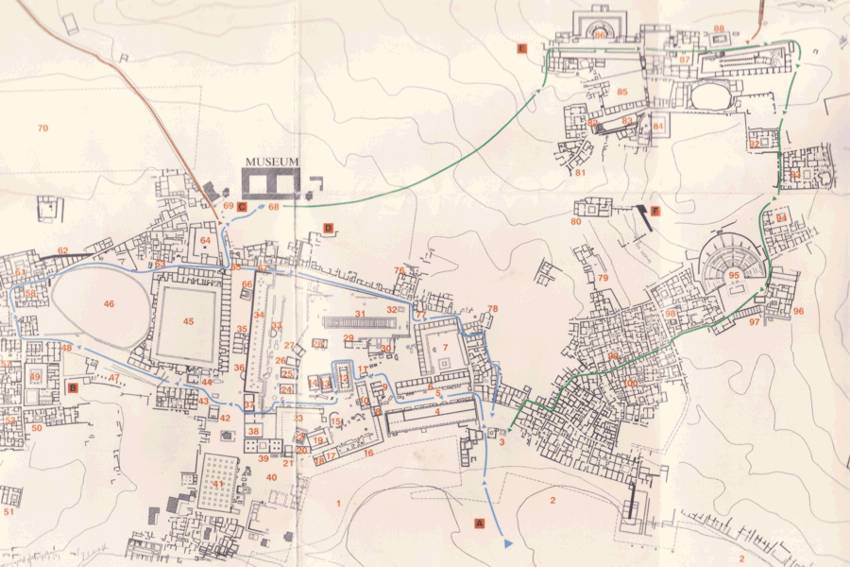 |
| Map of the Ruins of Delos |
Except for a few shortcuts, we took the blue route in the map above from the Sacred Port at the Sacred Harbor (#2) (yes, that's really what they're called) to the Museum (#68), except that we stayed at the edge of the Sacred Lake (#46) (see a pattern in the names?), which is where Leto is said to have given birth to Apollo and Artemis (and which has now been filled up with sacred dirt by the Greek government to prevent sacred malaria).
|
Our first hour or so on the island allowed us to wander toward the sacred lake and wallow (for lack of a better word) in the antiquity. |
Then we took the green route toward (but not up) Mount Kythnos and circled around, past the amphitheatre, back to the sacred waterfront.
|
|
Delos was amazing as expected – but, unexpectedly, surreal. I've seen enough ruins that merely walking in the footsteps of an ancient civilization is not jarring to me. (Awe inspiring, of course – but not jarring.) But in Delos, the ruins are so low (you can see across the top of much of it) and so dense and so overtaken with wildflowers that it gives the impression of a marble junkyard. Couple that with the loud, incessant background buzzing of flies and bees, and the fact that its layout lets everyone find an area to enjoy separately while always being able to see other visitors in the distance, and the experience was like no other I have found on this world. But it was so much like the world of the interactive game Myst that I must believe the programmers visited Delos and that it heavily influenced their work.
| Delos | Myst |
 |
|
| Now, I didn't say they were identical – just that they have a very similar feel. But if I'd had this screenshot from Myst with me on the island, I could have found something that looked even more like it. | |
So 12:15 came, and we returned to the dock for our short ferry ride back to Mykonos.
|
|
![]() With a little time before departing for Santorini, we had lunch near the waterfront back in Mykonos: Both of us ordered a Greek-salad-and-gyro combination. The salad was superb (made without lettuce, as is the custom); the gyro meat, however, was so tough that we didn't finish it. Then we walked up to the Philippi to retrieve our luggage, and then walked over to the Ferry Quay. I asked a lot of questions (as usual) to get our bearings, and we waited a short time for the Hellenic Seaways Flyingcat 4. It left Mykonos on the dot.
With a little time before departing for Santorini, we had lunch near the waterfront back in Mykonos: Both of us ordered a Greek-salad-and-gyro combination. The salad was superb (made without lettuce, as is the custom); the gyro meat, however, was so tough that we didn't finish it. Then we walked up to the Philippi to retrieve our luggage, and then walked over to the Ferry Quay. I asked a lot of questions (as usual) to get our bearings, and we waited a short time for the Hellenic Seaways Flyingcat 4. It left Mykonos on the dot.
We weren't there long, but Mykonos was fantastic in April, with great weather and few tourists; we picked the perfect time to come! But once you've tasted the food, seen the windmills, and been lost in the maze a few times, the experience is complete and it's time to move on (or move in); we picked the perfect amount of time for our stay.
I had been worried about transit times once we got to Santorini, so I booked this ferry trip in business class under the assumption that it would get us in and out faster. This was not the case: If anything, business class takes longer because it is upstairs; it does not, as I had assumed, have a separate gangway. We didn't even have a separate place for our luggage, but just put it in the same pile of bags that economy class uses. (This luggage thing causes Americans a lot of stomach churning because we assume that if something can be stolen, it will be. But veterans of the Greek ferries don't think twice about putting luggage in the bins near the exit, and forgetting about them until time to disembark.) But, fortunately, business class didn't really slow us down, either, as everyone was given a five-minute warning before the quick stop in Santorini ("arriving in Santorini, for immediate departure"; repeated a few times in both Greek and English). So we just bided our time up there, and availed ourselves of the better views (the higher windows didn't get much splashing, and were thereby free of grit), wide open spaces (only one other group was in the business class area), and snack bar (with uncomfortably obsequious service).
|
|
| Santorini |
We arrived in Santorini within 5 minutes of its scheduled time. As usual, all the warnings I had heard about delays and incompetence were unfounded.
In Santorini, the nomenclature gets a bit complicated. We've already established that the Cyclades island group is a subset of the Aegean Islands (broadly conceived, not to be confused with "Aegean Islands" referring to islands between Greece and Turkey outside the other groups), which themselves are a subset of the 1,400 or so Greek islands. Now
One of those things was the Minoan Eruption, around 1600 BCE. Though it was not as violent as the eruption cycle between several hundred thousand years and 21,000 years ago, it did a fair amount of damage – changing the lives of everyone in the eastern Mediterranean (and possibly China), and ending those of all who may have been left on Santorini (though archaeological evidence suggests an orderly evacuation was conducted). Importantly, it collapsed walls of the caldera between what are now the islands of Aspronisi and Thirasia, and between Thirasia and Thira; and it sank an island in the center, which may have been Atlantis. This explosion produced a plume extending into the stratosphere, an ash layer on Santorini 60 m deep, a tsunami of 35-150 m high (for comparison, the devastating 2004 tsunami was 30 m high), and climate changes as far away as California and China.
And it has been tied (albeit inconclusively) with far-reaching consequences of the greatest import:
- The Fall of the Minoan Civilization (c. 1450 BCE): There is debate over whether the Minoan Eruption was responsible for the sudden demise of the thriving (sea-faring) Minoan civilization, based in nearby Crete – but this is one of the most plausible explanations for their downfall.
- The Fall of the Xia Dynasty in China (c. 1618 BCE): The Xia fell at about this time to the Shang dynasty in the context of "yellow fog, a dim sun, then three suns, frost in July, famine, and the withering of all five cereals."
- The Exodus of the Jews from Egypt (c. 1450 BCE): Many of the ten plagues of Egypt – water turning to blood (perhaps a red tide); infestations of frogs, gnats, and flies (displaced insects followed by their predators); darkness; violent hail – could be attributed to an explosion of this magnitude or its aftereffects. Similarly, the parting of the sea and the subsequent destruction of the Egyptian army by a returning wave could be the result of tsunamis, which lower water levels before the flood. And the descriptions in Exodus of the Israelites being guided by a "pillar of smoke" by day and a "pillar of fire" by night could be references to the volcanic plume.
- The Fall of Atlantis: The minerals, ancient layout, and ancient construction techniques found on Santorini track well with Plato's description of Atlantis.
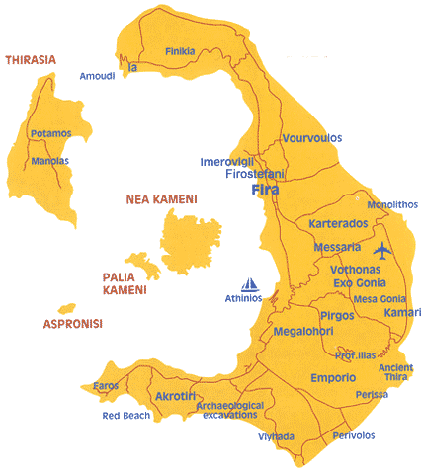 |
Map of Santorini |
But all was calm when we got there. We didn't even feel any tremors, which are apparently still common. (There was major devastation from an earthquake in 1954.)
The big boats still arrive in
| Scooting to Oia |
We picked up the scooters at the port, without complication. (Though there was a threat of rain, it was slight enough that we decided to keep with the scooter plan.) One of the ridiculous exercises I do for every trip is to get an International Driving Permit – it's always an inconvenience and an expense, and it has never been useful. Finally, though, I am vindicated: If Billy and I hadn't had these permits, we wouldn't have been able to rent the scooters. (Indeed, people continued asking for the permit throughout the trip, such as when we rented cars in Crete and Jordan; so much so that eventually I started carrying it in the pouch with my passport.)
 |
International Driving Permit |
We drove the length of Thira to the town of
|
|
In Oia, we were met by the hotel owner and walked through the center of town to the cliffside cave apartment. Now bear in mind that every journey begins with a Google search of "unusual hotel" followed by the name of the city. This is how we came up with a mountaintop observatory in Zermatt, Switzerland; hanging beds in Puerto Morelos, Mexico; a treehouse in San Ignacio, Belize; and, now, a cave in Oia. Because of the steep walls along the caldera, the traditional style of housing in Santorini is a cave apartment. A few of these have been excavated from the rubble of the 1954 quake, and are again in use, some of them on a rental basis. Lena's Cave Apartment is one of these, and it was great!
|
|
| Dinner in Ammoudi |
After checking in to the apartment, we went for dinner in
At the taverna, we had cheese "saganaki" and olives to start, and then fresh fried red mullet to share as the entré (which we had to order by the kilogram – or, actually, the fraction [3/4] of a kilogram). And then I got yogurt with candied quince on top (a local variation on the typical honey topping).
|
We were pleased by everything that Ammoudi had to offer us: the town, |
Then we returned up the hill (thankfully, on the scooters, not the stairs), to enjoy the view of Oia from our terrace by night.
|
|
| Main | ||||||||
| 20 | κʹ | |||||||
| 21 | Previous | Προγενέστερος | καʹ | |||||
| 22 | κβʹ | |||||||
| 23 | Next | Επόμενος | κγʹ | |||||
| 24 | κδʹ | |||||||
| 25 | κεʹ | |||||||
| 26 | ח׳ | |||||||
| 27 | ט׳ | |||||||
| 28 | ١٠ | |||||||
| 29 | ١١ | |||||||
| 30 | ١٢ | |||||||
| 1 | ١٣ | |||||||
| 2 | ١٤ | |||||||
| 3 | ١٥ | |||||||
| 4 | ١٦ | |||||||
| 5 | ١٧ | |||||||
| 6 | ١٨ | |||||||
